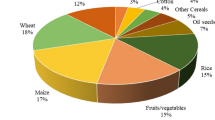Abstract
Methane is primarily a biogenic gas, which is implicated in global climate change. Among all the sources of methane emission, paddy fields form the most dominant source. An experiment was conducted with a common paddy crop (Oryza sativa var. Vishnuparag) by amending the soils with different organic manures and biofertilizers with a view to find out an inexpensive strategy to mitigate methane emission from the rice-fields. The results revealed that there was a seasonal change in the CH4 flux, registering a peak at heading stage in all treatments. The application of rice straw before flooding and the biofertilizer after flooding enhances CH4 efflux from the rice-fields significantly, while composts of cowdung and leaves did not stimulate CH4 production and, rather, decreased CH4 fluxes. As soil pH and temperature were optimum for methanogenesis, it was likely that the organic C and the redox potential mainly modulated methane production and its emission through rice plants.
Similar content being viewed by others
References
Bachelet, D. and Neue, H.-U: 1993, ‘Methane emission from wetland rice areas of Asia', Chemosphere 26(1–4), 219.
Connell, W. E. and Patrick, W. H. Jr.: 1969, ‘Reduction of sulphate to sulphide in waterlogged soil', Soil Sci. Soc. Am. Proc. 33, 711.
Crawford, W.: 1984, ‘Methane production in Minnesota peat lands', Appl. Environ. Microbiol. 47, 1266.
Dommergues, Y. R. and Rinaudo, G.: 1979, ‘Factors affecting N2-fraction in the rice rhizosphere, in nitrogen and rice', ed. by the International Rice Research Institute, Los Banos. Philippines, pp. 241–260.
Itou, J. and Imura, K.: 1989, ‘Decomposition of rice straw and evolution of gas from paddy field of clayey gley soil in Horkuriku district of Japan', Jap. J. Soil. Sci. Pl. Nutri. 60, 290.
Khalil, M. A. K. and Rasmussen, R. A.: 1990, ‘Atmospheric methane: recent global trends', Environmental Science and Technology 24, 549.
Khalil, M. A. K., Rasmussen, R. A., Wang, M.-X and Ren, L.: 1991, ‘Methane emission from rice fields in China', Environ. Sci. Technol. 25, 979.
Mariko, S., Harazono, Y., Owa, N. and Noucji, I.: 1991, ‘Methane in flooded soil, water and the emission through rice plants to the atmosphere', Environ. Exp. Bot. 31, 343.
Martin, J. K.: 1977, ‘Factors influencing the loss of organic carbon from wheat roots', Soil Biochem. 9, 1.
Matsuo, T.: 1969, ‘Morphology and Functions of Rice Plants. 6th edn., Assoc. Agric. Technol., Tokyo, Japan.
Minami, K. and Neue, H.-U: 1994, ‘Rice paddies as a methane source', Clim. Change 27, 13.
Neue, H.-U. and Sass, R.: 1994, ‘Trace gas emission from rice fields', in: Prinn R. (ed.), Global atmospheric-biospheric chemistry. Plenum Press, New York, pp. 119–148.
Neue, H,-U., Ziska, L. H., Matthews, R. B. and Dai, Q.: 1995, ‘Reducing Global Warming', Geojournal 35(3), 351.
Oremland, R. S., March, L.M. and Polcin, S.: 1982, ‘Methane production and simultaneous sulphate reduction in anoxic salt march sediments', Nature 296, 143.
Oremland, R. S.: 1988, ‘Biogeochemistry of methanogenic bacteria', in: Zehnder A. J. B. (ed.), Biology of anaerobic microorganisms. John Wiley, New York, 641.
Parashar, D. C., Rai, J., Gupta, P. K. and Singh, N.: 1991, ‘Parameters affecting methane emission from paddy fields', Indian J. Radio and Space Physics 20, 12.
Parashar, D. C. et al.: 1996, ‘Methane budget from paddy fields in India', Chemosphere 33(4), 737.
Piper, C. S.: 1966, Soil and plant analysis, Wiley Interscience, New York.
Rasmussen, R. A. and Khalil, M. A. K.: 1981, ‘Atmospheric methane: Trends and seasonal cycles', J. Geophys. Res. 86, 9826.
Reddy, K. R. and Patrick, W. H. Jr.: 1984, ‘Nitrogen transformations and loss in flooded soils and sediments'. CRC Crit. Rev. Environ. Control. 13, 273.
Sass, R. L., Fisher, F. M., Harcombe, P. A. and Turner, F. T.: 1991, ‘Mitigation of methane emissions from rice fields: Possible adverse effects of incorporated rice straw', Global Biogeochem. Cycles. 5, 275.
Sass, R. L., Fisher, F. M., Turner, F. T. and Jund, M. F.: 1991, ‘Methane emission from fields as influenced by solar radiation temperature and straw incorporation', Global Biogeochem. Cycles 5, 335.
Scheel, H. E., Brunke, E. G. and Seiler, W.: 1989, ‘Long-term measurements of tropospheric trace gases at the monitoring station cape point, South Africa'. WMO special Environmental report. No. 724, 127.
Seiler, W., Holzapfel-Pschorn, A., Conrad, R. and Scharffe, D.: 1984, ‘Emission of methane from rice paddies', J. Atmos. Chem. 1, 241.
Tsutsuki, K. and Ponnamperuma, F. N.: 1987, ‘Behavior of anaerobic decomposition products in submerged soils. Effects of organic material amendment, soil properties, and temperature', Soil Sci. Plant Nutr. 33(1), 13.
Waid, G. S.: 1974, ‘Decomposition of roots', in: C. H. Dickinson and G. J. F. Pugh (eds.), ‘Biology of plant litter decomposition', Vol 1, London, pp. 175–211.
Wang, Z., Delaine, R. D., Masscheleyn, P. H. and Patrick, W. H. Jr.: 1993, ‘Soil redox and pH effects on methane production in a flooded rice soil', Soil Sci. Soc. Am. J. 57, 382.
Yagi, K. and Minami, K.: 1990, ‘Effect of organic matter application on methane emission from some Japanese rice fields', Soil Sci. Plant Nutr. 36, 599.
Yagi, K. and Minami, K.: 1991, ‘Emission and production of methane in the paddy fields of Japan', JARQ 25, 165.
Zehnder, A. J.: 1978, ‘Ecology of methane formation', in: R. Mitchell (ed.), ‘Water Pollution Microbiology', 2, pp. 349–376. Wiley, New York.
Author information
Authors and Affiliations
Rights and permissions
About this article
Cite this article
Agnihotri, S., Kulshreshtha, K. & Singh, S.N. Mitigation Strategy to Contain Methane Emission from Rice-Fields. Environ Monit Assess 58, 95–104 (1999). https://doi.org/10.1023/A:1006081317688
Issue Date:
DOI: https://doi.org/10.1023/A:1006081317688




